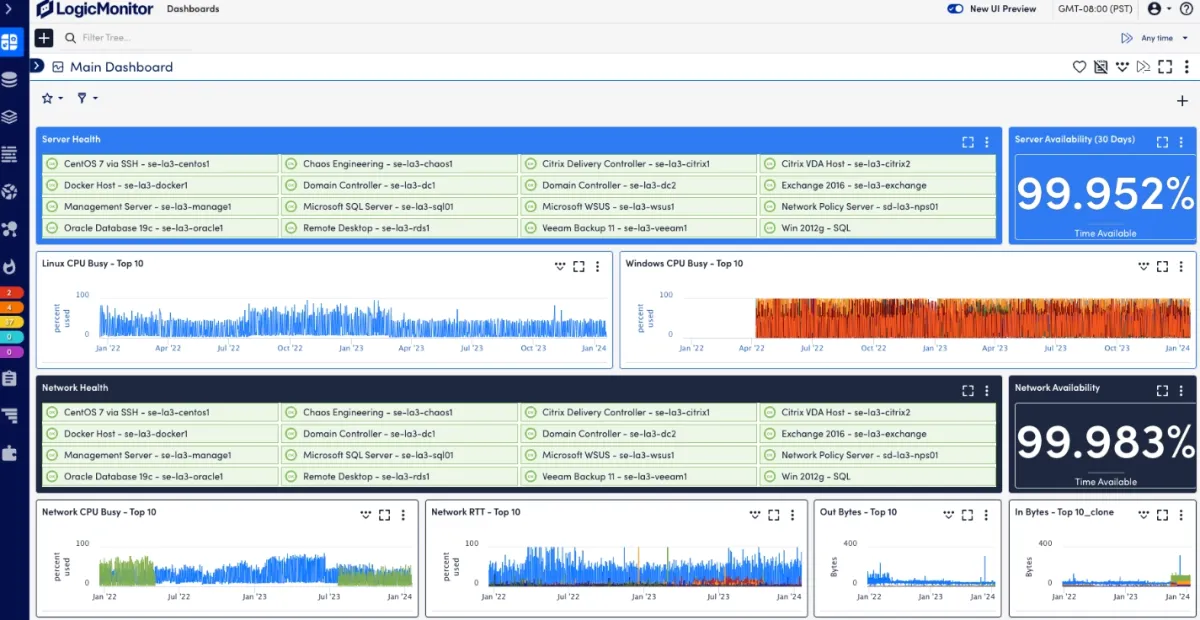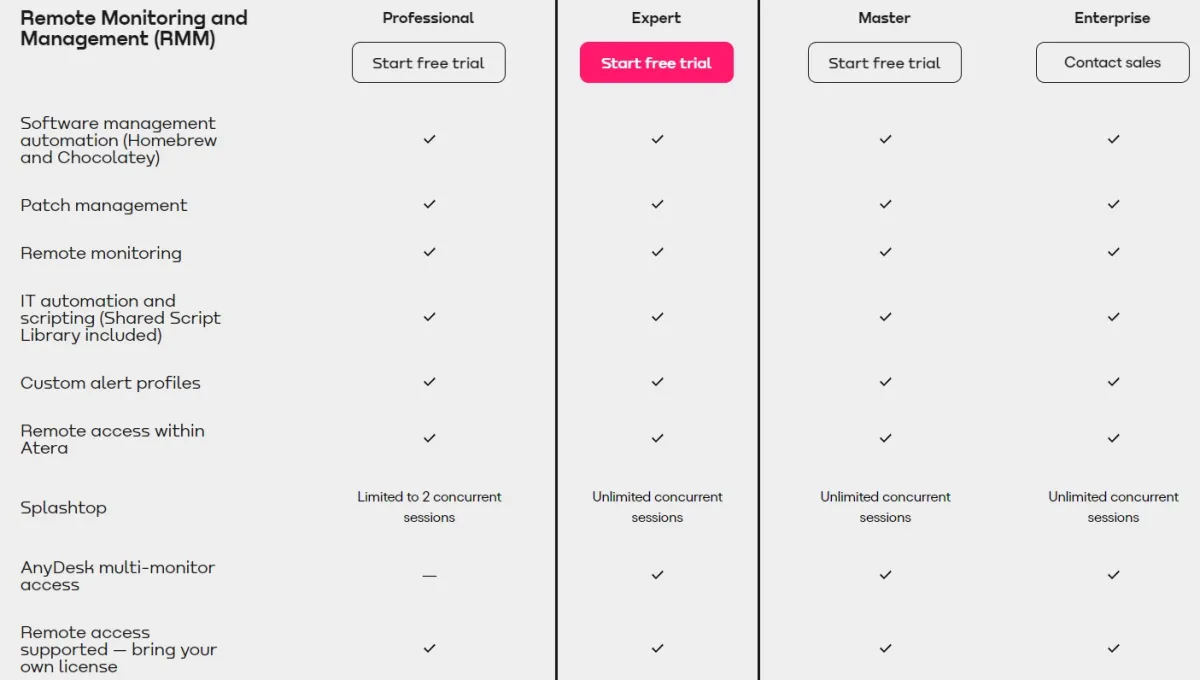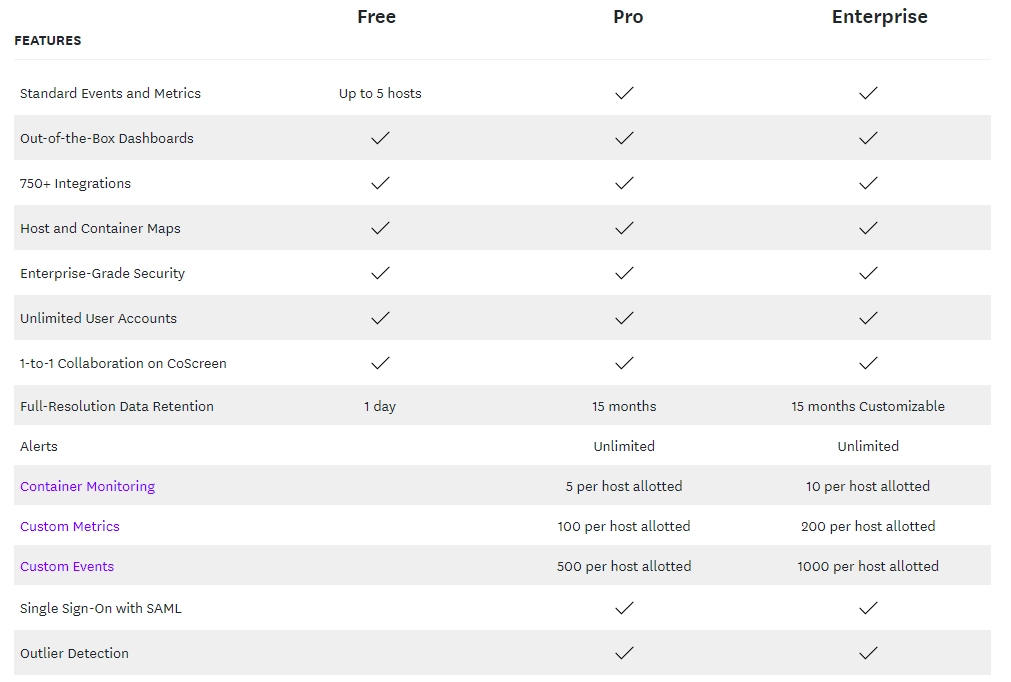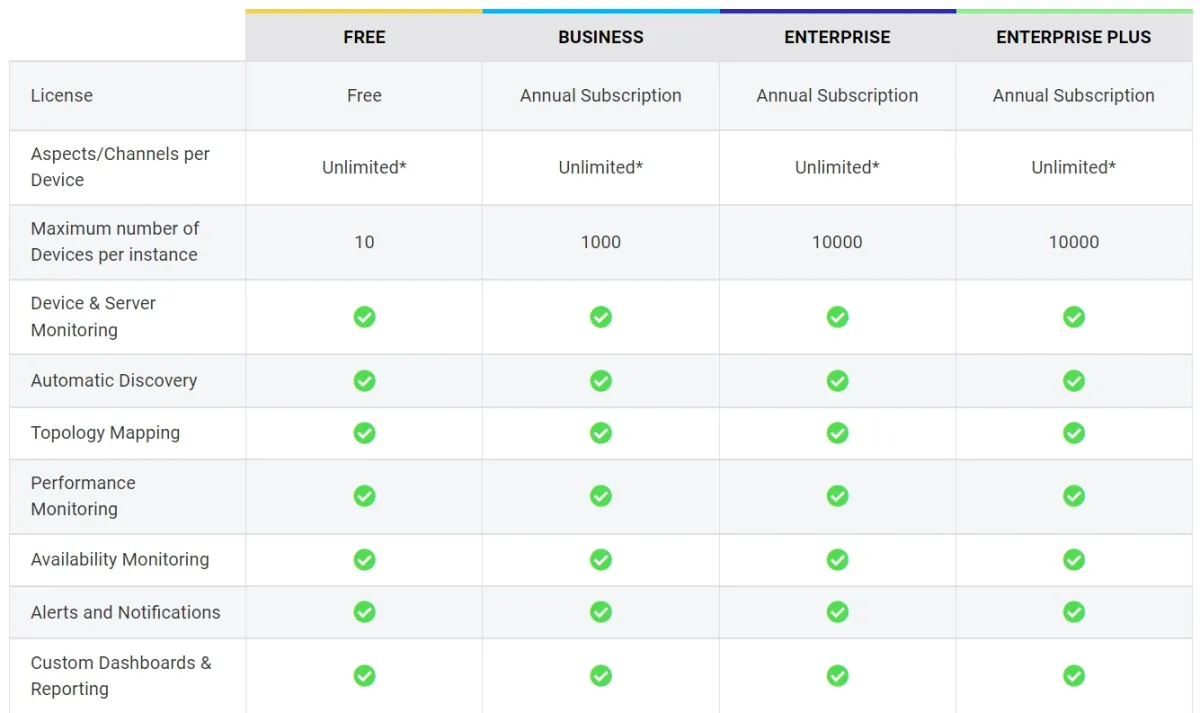Network monitoring service pricing is shaped by several factors. Providers typically offer different pricing models such as per-device, per-host, or per-technician billing. We reviewed pricing of top 5 network monitoring software to identify the most affordable one:
| Software | For | |
|---|---|---|
1. | is an all-in-one monitoring solution focused on optimizing network performance through real-time traffic and infrastructure insights. | |
2. | high-performance, scalable monitoring | |
3. | AI-driven predictive insights | |
4. | windows-focused deep observability | |

Top Network Monitoring Services Pricing Comparison
| Vendors | $ per device/year* | Pricing drivers | Notes | Key Features |
|---|---|---|---|---|
| Paessler PRTG Network Monitor | 14-34 | # of aspects** | Starts at $2,149/year for up to 50 devices | –Only brand among market leaders with sole focus on network branding |
| Progress WhatsUp Gold | 18-44 | # of devices Features | Free (up to 10 devices) Starts at ~$18/device/month ($899/year for 50 devices) | – Device & server monitoring – Performance & availability monitoring – Application monitoring, network traffic analysis, and log management |
| Datadog | 180 – 408 | # of hosts*** Features | Free up to 5 devices | – 750+ integrations – Machine learning-based alerts – Unlimited user accounts |
| LogicMonitor | 264 | # of resources # of GBs of data retention for log intelligence | $264 is per resource for Infrastructure & Cloud IaaS monitoring | – Infrastructure, Cloud IaaS, PaaS, and container monitoring – AI-powered troubleshooting |
| Atera | 163 | # of technicians**** | Starting at $ 2,028/year/technician | – Provides on RMM for MSPs and monitoring solutions for IT departments – Scripting, patch management, and reporting |
* When the solution is used to manage the max number of prices allowed by the package. These prices can be considered the minimum prices.
** Paessler PRTG uses a pricing model based on the number of aspects or sensors monitored. One aspect equals ~10 devices.1
***Datadog pricing is per host, with different tiers for basic to advanced features. A “host” refers to any physical or virtual operating system instance that is being monitored. You can consider it as a device.2
**** A technician refers to a user who has access to the Atera platform to manage IT operations. The pricing is based on the number of technicians, not on the number of devices.3
****LogicMonitor charges based on specific resources. A resource is not strictly equivalent to a device. Instead, it refers to any unique infrastructure component that is monitored.4
Top Network Monitoring Services Features
| PRTG | LogicMonitor | Atera | Datadog | WhatsUp Gold | |
|---|---|---|---|---|---|
| Container Monitoring | PRTG 500 plan | Cloud PaaS & Container Monitoring Plan | NA | Pro and Enterprise plans | Enterprise and Enterprise Plus plans |
| Remote Management and Monitoring | PRTG 500 plan | Infrastructure and Cloud Plan | Professional | Pro and Enterprise plans | Business, Enterprise, and Enterprise Plus |
| AI-powered Troubleshooting | ❌ | ✅ | ✅ | ✅ | ❌ |
| Log Management | ❌ | with Layered AI add-on with any plan. | ❌ | Pro and Enterprise plans | Enterprise and Enterprise Plus plans |
| Network Traffic Analysis | PRTG 500 plan | ✅ | ❌ | Pro and Enterprise plans | Business, Enterprise, and Enterprise Plus |
| Patch Management | ❌ | ❌ | ✅ | ❌ | ❌ |
Affordability Comparison:
- Small Network (Up to 50 devices/hosts): WhatsUp Gold’s Business Plan at $899/year for 50 devices is the most affordable for small deployments.
- Mid-Sized Network: PRTG’s tiered pricing could be more cost-effective for networks with up to 1,000 devices. For example, €2,899/year (~$3,200) for 1,000 sensors.
- Enterprise-Level: Atera’s per-technician pricing might be affordable depending on how many technicians manage the infrastructure, but Datadog’s Enterprise plan ($23 per host/month) could quickly add up for larger environments.
Paessler PRTG
Paessler PRTG Network Monitor is an all-in-one network monitoring tool that tracks the performance and availability of devices. It offers real-time monitoring, customizable alerts, and reporting to ensure network health. Designed for businesses of all sizes, it supports both on-premises and cloud deployment options and scales based on the number of sensors used for monitoring different elements like bandwidth, traffic, and hardware.

Paessler PRTG pricing depends on:
- PRTG 500: $2,149/year (up to 500 sensors)
- PRTG 1000: $3,899/year (up to 1,000 sensors)
- PRTG 2500: $8,099/year (up to 2,500 sensors)
- PRTG 5000: $14,199/year (up to 5,000 sensors)
- PRTG 10000: $17,899/year (up to 10,000 sensors)
If you have an existing PRTG Network Monitor subscription and need more sensors, you can upgrade to a larger license. There are two scenarios:
- New Subscription Period: The upgrade takes effect when the new subscription starts, with no change to your license key.
- Mid-Term Upgrade: The upgrade is effective immediately, and a new subscription period begins. You’ll receive a discount for unused days from your previous plan, and your license key remains unchanged.
You can also upgrade to PRTG Enterprise Monitor or PRTG Hosted Monitor.
LogicMonitor
LogicMonitor is a cloud-based monitoring platform that provides visibility, including networks, servers, and cloud services. It automates performance monitoring and offers features like advanced alerting, dashboards, and predictive insights to help prevent issues.
LogicMonitor offers several pricing plans for different types of monitoring:
- Infrastructure Monitoring: $22 per resource/month, covering servers, virtual machines, storage, and networks.
- Cloud IaaS Monitoring: $22 per resource/month for AWS EC2, Azure VM, GCP Compute Engine, and more.
- Wireless Access Points Monitoring: $4 per resource/month, for devices like Juniper Mist, Cisco Meraki, and others.
- Cloud PaaS & Container Monitoring: $3 per resource/month, covering AWS, Azure, GCP, Kubernetes, and Docker.

Atera
Atera offers tools for remote access, automation, patch management, and ticketing, making it suitable for managed service providers (MSPs). Atera provides flexible pricing, typically charged per technician, with different plans based on features such as reporting, audit logs, and security integrations.
Atera offers four pricing plans:
- Professional: €149/month (billed annually). Includes remote management, monitoring, access, patch management, and more.
- Expert: €189/month (billed annually). Adds unlimited Splashtop sessions, AnyDesk access, chat, and extended audit logs.
- Master: €219/month (billed annually). Includes custom reports, longer audit log retention, and data recovery.
- Enterprise: Custom pricing. Includes enterprise-grade services like SSO, private repositories, and premium support.

Datadog
Datadog is a cloud-based monitoring and analytics platform. It integrates with hundreds of services and tools to monitor servers, databases, cloud services, and more.
- Free: $0/month, includes core features with 1-day metric retention and up to 5 hosts.
- Pro: $15/month per host (billed annually), includes 750+ integrations, out-of-the-box dashboards, and 15-month metric retention.
- Enterprise: $23/month per host (billed annually), adds machine learning-based alerts and live processes.
- DevSecOps Pro: $22/month per host, includes security features like continuous scanning and compliance frameworks.
- DevSecOps Enterprise: $34/month per host, includes advanced security features.

Progress WhatsUp Gold
- Free Edition: $0, allows monitoring of up to 10 devices.
- Business: $899/year for monitoring up to 50 devices, scalable to 1,000 devices.
- Enterprise: $1,499/year for 50 devices, tailored for businesses monitoring over 1,000 devices.
- Enterprise Plus: $2,199/year for 50 devices, includes all additional add-ons.

Frequently Asked Questions
What Are the Types Of Network Monitoring Solutions?
Network monitoring software
Network monitoring software is a type of software that monitors network performance, security, and events.
Examples of network monitoring software include PRTG Network Monitor, SolarWinds Network Performance Monitor, and Nagios Core.
Network monitoring tools
Network monitoring tools are specialized tools that monitor specific aspects of network performance, security, and events.
Examples of network monitoring tools include packet capture tools, network protocol analyzers, and network security scanners.
Network monitoring services
Network monitoring services are cloud-based or managed services that provide network monitoring and management capabilities.
Examples of network monitoring services include managed service providers (MSPs) and cloud-based network monitoring platforms.
What Are Network Monitoring Service Pricing Models?
Per-device pricing: charges based on the number of devices monitored.
Per-user pricing: charges based on the number of users accessing the network monitoring system.
Tiered pricing: charges based on the level of service or features required.
All-you-can-eat pricing: charges a flat fee for unlimited monitoring.
What factors influence the cost of network monitoring services?
The cost of network monitoring services can be influenced by several factors, including the size of your network (number of devices, servers, and endpoints), the level of monitoring required (basic uptime monitoring vs. advanced security monitoring), the complexity of your network architecture, and the frequency of reporting. Additional features like real-time alerts, advanced analytics, and integration with other systems can also affect pricing.
Is there a free version or trial period available for network monitoring services?
Many network monitoring service providers offer a free version with limited features or a free trial period, typically ranging from 14 to 30 days. These trials allow you to evaluate the service’s effectiveness before committing to a paid plan. However, free versions may not include advanced features like detailed reporting, security monitoring, or integration with third-party tools.
What is included in a typical network monitoring service pricing?
A typical network monitoring service package may include:
Basic Monitoring: Monitoring of network uptime, device health, and bandwidth usage.
Alerts and Notifications: Real-time alerts for network issues or outages.
Reporting: Regular reports on network performance and potential vulnerabilities.
Security Features: Some packages include malware detection, firewall monitoring, and intrusion detection.
Support: Access to customer support for troubleshooting and network-related inquiries.
Are there any additional costs beyond the base pricing?
Yes, there could be additional costs depending on your specific needs. These may include:
Setup Fees: One-time fees for initial setup and configuration of the network monitoring system.
Customization: Charges for tailoring the service to your specific network environment.
Advanced Features: Additional fees for enhanced security monitoring, data analytics, or integration with other software tools.
Support Levels: Some providers charge extra for premium support, such as 24/7 access to a dedicated support team.
For more on network monitoring
- Network Performance Monitoring to Maximize Business Efficiency
- Top 5 Network Performance Monitoring Tools
- 10 Network Performance Best Practices to Improve Network Optimization
- 26 Network Performance Metrics to Measure Network Health
External Links
- 1. “PRTG Network Monitoring Pricing” PRTG. Retrieved on 22 August, 2024.
- 2. “Datadog Pricing” Datadog. Retrieved on 22 August, 2024.
- 3. “Atera Pricing” Atera. Retrieved on 23 August, 2024.
- 4. “LogicMonitor Pricing” LogicMonitor. Retrieved on 23 August, 2024.




Comments
Your email address will not be published. All fields are required.